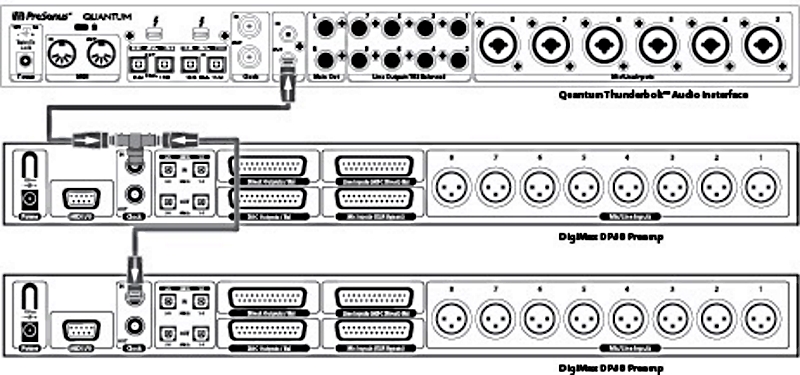
There are three basic clocking systems in common use in digital-audio systems:
Self-clocking. In a self-clocking system, the clock signal is embedded in the audio stream. Samples are streaming in real time, with the clock marking the start time of each sample. The receiving device extracts the embedded clock signal from the digital audio. Self-clocking is implemented in every digital audio protocol (ADAT, S/PDIF, AES/EBU, etc.), and all PreSonus devices that offer these protocols employ self-clocking systems for those connections.
Distributed. Commonly used in professional environments with multiple digital devices, distributed clocking systems provide more stable clock because the clocking stream that does not contain audio. This makes the clocking stream cleaner than a self-clocking system. In a distributed system, sync signals and audio signals are separate.
The clocking signal in a distributed clocking system is called word clock. (A word, in this case, is a fixed-size group of digital bits.) A word-clock generator creates digital pulses that control the frequency of the internal oscillator of each device to avoid frequency drift. Word clock does not carry location information, the way time code does, nor does it carry audio information; it only determines the rate at which samples should occur.
Word clock is used for a few types of distributed-clocking systems but the most common in professional audio uses a BNC connector. In this system, word clock is sent over dedicated, shielded, coaxial cables with standard twist-lock, BNC-type connections on each end. The cables are rugged and can carry clock signals much farther than standard optical cable. BNC connections are made in several impedances but PreSonus devices require an impedance of 75Ω to achieve consistent sync. Every PreSonus device equipped with ADAT, is also equipped with BNC word-clock for dedicated, stable clocking.
Reclocking. Computer transport protocols (FireWire, USB, Thunderbolt) don’t use an embedded clock for timing; instead, they use a process called reclocking, in which the audio stream is divided into packets of data that are transmitted sequentially. The receiving device buffers the signal, reassembles the sample stream, and then sends the audio signal from the buffer at the appropriate time, as determined by the device’s sample rate. This ensures accurate timing when going from an audio interface to a computer and back.
Synchronizing Multiple Digital Audio Devices
Whether you are using BNC or another digital output to generate word clock, it is necessary to designate one device as the “master” word-clock device to which all other digital devices are synced, or “slaved.” Many digital devices perform equally well as a master or a slave, although some devices must be one or the other. Synchronizing a device to a lesser-quality clock source is likely to degrade its performance, and not all word-clock generators are created equal. You generally need to determine which device has the best clock and to designate that device as the word-clock master. This is done with careful listening and A/B testing.
Once you’ve determined which device is to be your master clock, you will need to sync the remaining digital devices through series or parallel distribution or some combination thereof. Of course, if your digital-device chain only consists of one master and one slave, syncing the two is as simple as connecting a BNC word-clock cable from the output of your master device to the input of the device you are slaving.
When working with multiple slaved devices, the job gets a bit more complicated.
Series distribution requires that your digital devices have both a BNC word-clock input and a BNC word-clock output.
Parallel distribution uses a BNC T-connector attached to the BNC word-clock input of each slaved device. This allows the word-clock signal to be sent to that device and then sent on to another device. A BNC word-clock output on the slaved devices is not used for parallel word-clock distribution. If the last device in the chain does not have a word-clock terminate switch, you will need to attach a BNC terminator plug to the other side of the T-connector. This helps to stabilize the word-clock sync and keep the word-clock signal clean. Both word-clock terminator plugs and BNC T-connectors can be purchased at most recording-supply retailers.
A third option for syncing your digital devices is to purchase a high-quality, dedicated word-clock generator. Many engineers believe that using dedicated word-clock generators enhances the performance of digital audio devices more effectively than series or parallel word-clock distribution. A dedicated word-clock generator and distribution amplifier exists for one purpose and one purpose only: to be a master clock.
Word-clock generators usually have one BNC word-clock input and multiple BNC word-clock outputs, and sometimes they have AES, S/PDIF, or ADAT outputs to make them compatible with as many types of digital devices as possible. Without a dedicated word-clock generator, it is necessary to split the master device’s word-clock signal by daisy-chaining the slaved devices as described earlier. Because of this, many engineers feel that the resulting digital audio signals will be of a higher quality when a dedicated word-clock generator is used; in this way, all digital devices are receiving the same digital pulse from the same source at exactly the same time.
Whichever approach you use, it is always advisable to use quality BNC cables that are no longer than necessary for the job. As with audio cabling, it is good to keep word-clock cables separate from AC cable lines or other possible sources of interference.
This article provided by PreSonus. Read the original article and more technical content here.

